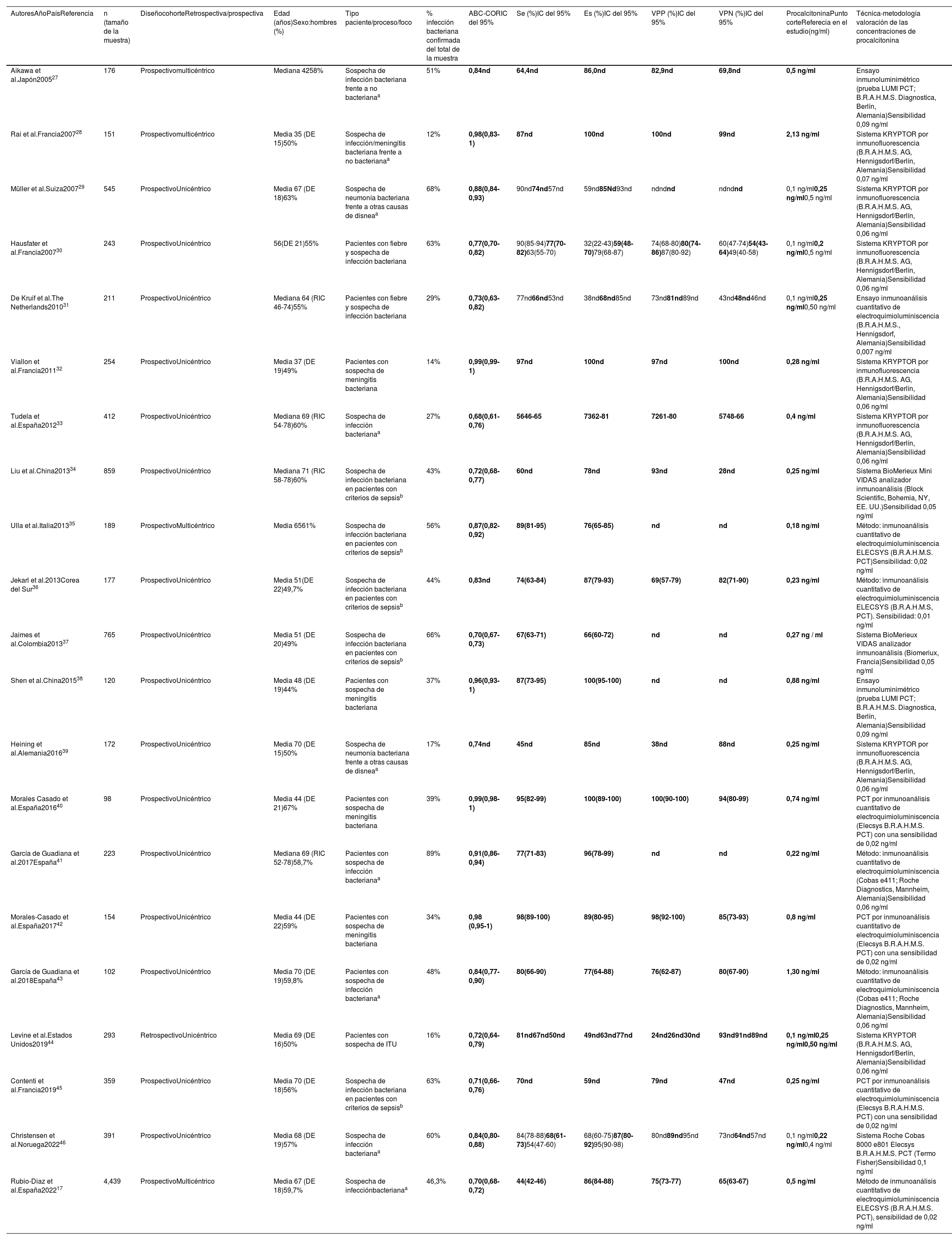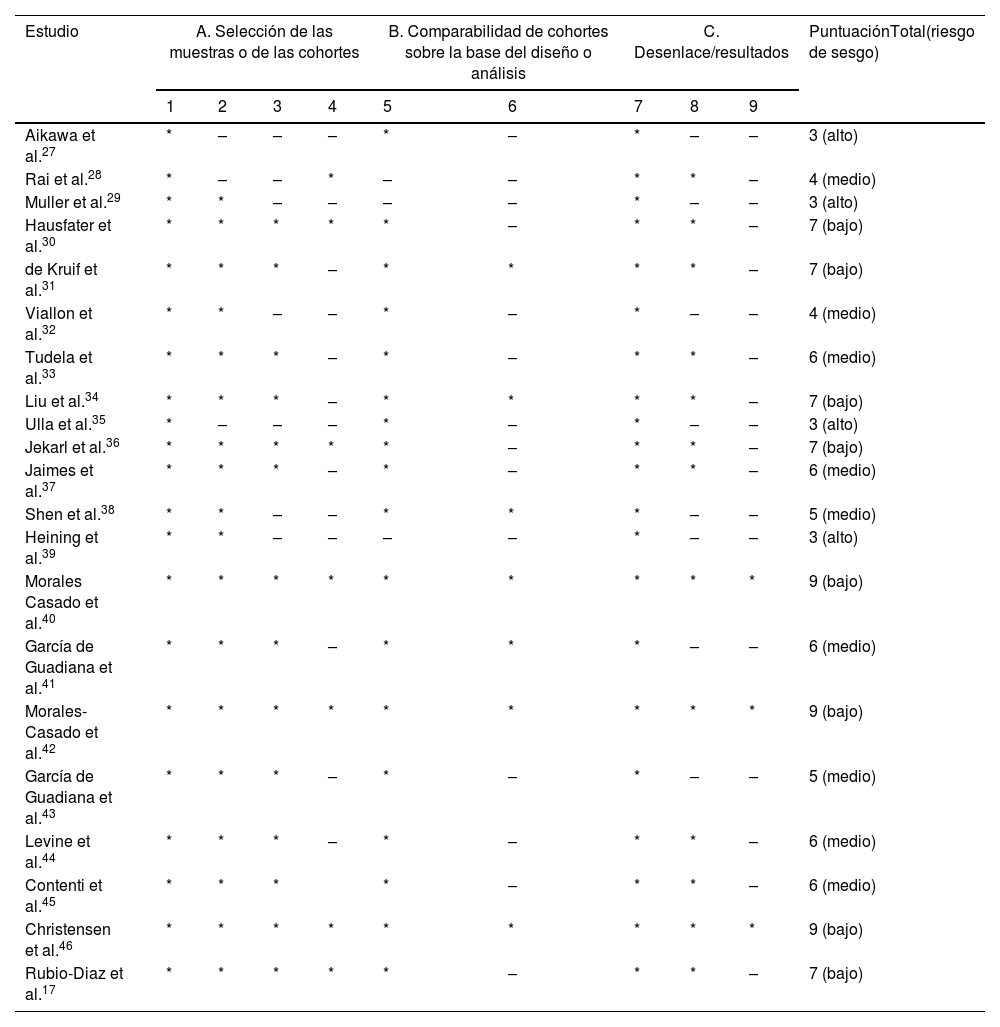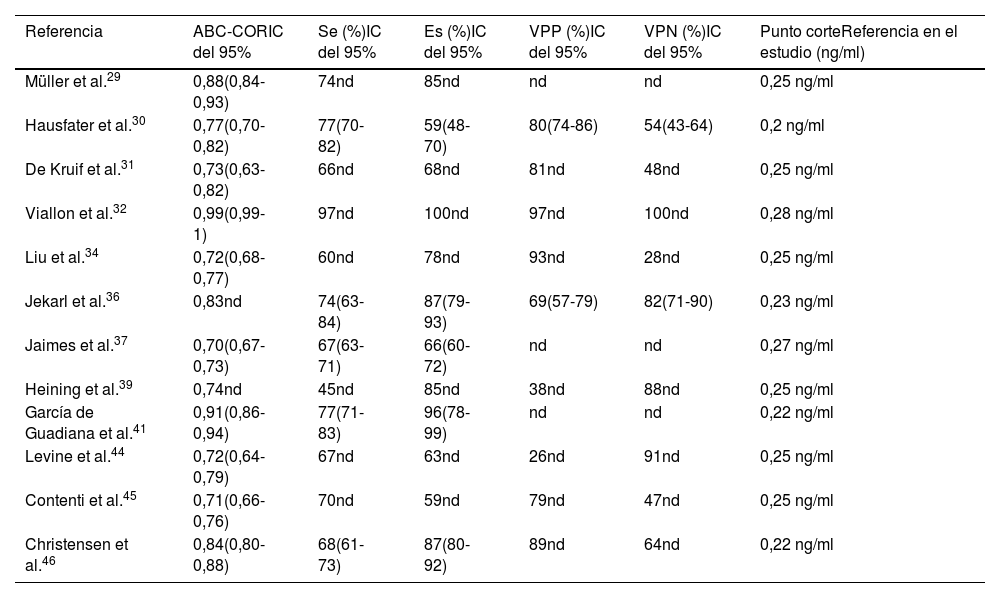La atención de pacientes con sospecha de un proceso infeccioso en los servicios de Urgencias Hospitalarios (SUH) supone el 15%-35% de todas las atenciones diarias en estas áreas asistenciales en España y en Latinoamérica. La administración precoz y adecuada del tratamiento antibiótico (AB) y la toma inmediata de otras decisiones diagnóstico-terapéuticas repercuten directamente en la supervivencia de los enfermos con infección bacteriana grave. El objetivo principal de esta revisión sistemática es investigar la precisión diagnóstica de la PCT para predecir infección bacteriana en los pacientes adultos atendidos con sospecha clínica de infección en el SUH, así como analizar si los distintos estudios logran identificar un valor específico de PCT como el más relevante desde el punto de vista diagnóstico de decisión clínica que pueda recomendarse para la toma de decisiones en los SUH.
MétodoSe realiza una revisión sistemática siguiendo la normativa PRISMA en la base de datos de PubMed, Web of Sciencie, EMBASE, Lilacs, Cochrane, Epistemonikos, Tripdatabase y ClinicalTrials.gov desde enero del 2005 hasta 31 mayo del 2023 sin restricción de idiomas y utilizando una combinación de términos MESH: «Procalcitonin», «Infection/Bacterial Infection/Sepsis», «Emergencies/Emergency/Emergency Department», «Adults» y «Diagnostic». Se incluyeron estudios de cohortes observacionales (analíticos de rendimiento diagnóstico). Para valorar la calidad del método empleado y el riesgo de sesgos de los artículos incluidos se utilizó la Newcastle-Ottawa Scale (NOS). No se realizaron técnicas de metaanálisis, pero los resultados se compararon narrativamente.
ResultadosSe identificaron un total de 1.323 artículos, de los cuales se analizaron finalmente 21 que cumplían los criterios de inclusión. Los estudios incluyen 10.333 pacientes con 4.856 infecciones bacterianas (47%). Ocho estudios fueron calificados de calidad alta, 9 moderada y 4 baja. El ABC-COR de todos los estudios se sitúa desde 0,68 (IC del 95%: 0,61-0,72) hasta 0,99 (IC del 95%:0,98-1). El valor de PCT 0,2-0,3 ng/ml es el más utilizado y propuesto hasta en 12de los trabajos que se incluyen en esta revisión cuyo rendimiento medio estimado es de un ABC-COR de 0,79. Si solo se tienen en cuenta los resultados de los 5 estudios de alta calidad que utilizan un punto de corte 0,2-0,3 ng/ml de PCT, el resultado medio estimado del ABC-COR es 0,78 con Se: 69% y Es: 76%.
ConclusionesLa PCT tiene una precisión diagnóstica de infección bacteriana considerable en los pacientes atendidos en los SUH por los distintos procesos infecciosos. El punto de corte 0,25 (0,2-0,3) ng/ml se ha posicionado como el más adecuado para predecir la existencia de infección bacteriana y se puede utilizar como ayuda para descartar esta razonablemente.
The care of patients with a suspected infectious process in hospital emergency departments (ED) accounts for 15%-35% of all daily care in these healthcare areas in Spain and Latin America. The early and adequate administration of antibiotic treatment (AB) and the immediate making of other diagnostic-therapeutic decisions have a direct impact on the survival of patients with severe bacterial infection. The main objective of this systematic review is to investigate the diagnostic accuracy of PCT to predict bacterial infection in adult patients treated with clinical suspicion of infection in the ED, as well as to analyze whether the different studies manage to identify a specific value of PCT as the most relevant from the diagnostic point of view of clinical decision that can be recommended for decision making in ED.
MethodA systematic review is carried out following the PRISMA regulations in the database of PubMed, Web of Science, EMBASE, Lilacs, Cochrane, Epistemonikos, Tripdatabase and ClinicalTrials.gov from January 2005 to May 31, 2023 without language restriction and using a combination of MESH terms: “Procalcitonin”, “Infection/ Bacterial Infection/ Sepsis”, “Emergencies/ Emergency/ Emergency Department”, “Adults” and “Diagnostic”. Observational cohort studies (diagnostic performance analyses) were included. The Newcastle-Ottawa Scale (NOS) was used to assess the quality of the method used and the risk of bias of the included articles. No meta-analysis techniques were performed, but results were compared narratively.
ResultsA total of 1,323 articles were identified, of which 21 that met the inclusion criteria were finally analyzed. The studies include 10,333 patients with 4,856 bacterial infections (47%). Eight studies were rated as high, 9 as moderate, and 4 as low. The AUC-ROC of all studies ranges from 0.68 (95% CI: 0.61-0.72) to 0.99 (95% CI: 0.98-1). The value of PCT 0.2-0.3 ng/ml is the most used and proposed in up to 12of the works included in this review whose average estimated performance is an AUC-ROC of 0.79. If only the results of the 5 high-quality studies using a cut-off point of 0.2-0.3 ng/ml PCT are taken into account, the estimated mean AUC-COR result is 0.78 with Se:69% and Es:76%.
ConclusionsPCT has considerable diagnostic accuracy for bacterial infection in patients treated in ED for different infectious processes. The cut-off point of 0.25 (0.2-0.3) ng/ml has been positioned as the most appropriate to predict the existence of bacterial infection and can be used to help reasonably rule it out.
Artículo
Diríjase desde aquí a la web de la >>>FESEMI<<< e inicie sesión mediante el formulario que se encuentra en la barra superior, pulsando sobre el candado.

Una vez autentificado, en la misma web de FESEMI, en el menú superior, elija la opción deseada.

>>>FESEMI<<<











